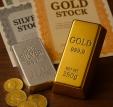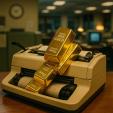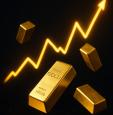War and Inflation
While grieving over the horror of September 11, 2001, American investors must not lose sight of the investment implications of the new war on terrorists. It has been quite some time since the U.S. was involved in a protracted armed struggle. A review of history reveals that diversification across asset classes is more vital now than ever.
On the morning of September 11, 2001 America's future was transformed. Gone is talk of surpluses, gone is talk of the Social Security lockbox, gone is an era of unprecedented prosperity and security.
Just as America is mobilizing, uniting and changing, the markets are adapting and investors must adapt along with them. Clearly, gold bullion is no longer the answer. It provides neither the diversification nor the safe haven in times of crisis that it did decades ago. So where are investors to turn?
Before we answer that question, we should first look back at history for some guidance on the economic conditions the financial markets are likely to face during and after a major war.
The Fiscal and Monetary Effects of War
War has a profound effect on the economy, our government and its fiscal and monetary policies. These effects have consistently led to high inflation. For that reason, investors must take action to insulate their portfolios against the effects of that inflation. They need to diversify into investments that not only protect their wealth from high inflation, but will actually benefit from higher inflation.
David Hackett Fischer is a Professor of History and Economic History at Brandeis. For our purposes, the most important thing about his book, The Great Wave, Price Revolutions and the Rhythm of History, is that he discusses linkages between economic trends, social tendencies, political events and cultural processes. He finds that extended periods of price stability are always marked by faith in order, harmony, progress and reason. By contrast, periods of high inflation are caused by, and cause, a breakdown in order and a loss of faith in political institutions. He also finds that war is a triggering influence on inflation, political disorder, social conflict and economic disruption.
The type of inflation that is associated with wars usually arises from increases in aggregate demand. In time of war, government spending for military purposes stimulates demand throughout an economy, at the same time that a shift of workers from productive labor into war production causes a decline in aggregate supply.
War also causes the type of inflation that results from a rapid expansion of money and credit. "In World War I, the American people were characteristically unwilling to finance the total war effort out of increased taxes. This had been true in the Civil War and would also be so in World War II and the Vietnam War. Much of the expenditures in World War I, were financed out of the inflationary increases in the money supply." (See "American Economic History," Scheiber, Vatter and Faulkner)
War usually leads to the type of inflation which is caused by inflationary expectations. Professor Fischer explains:
"It occurs when people begin to raise prices not because of actual changes in supply or demand or cost or the size of the money supply, but out of fear that some such changes might happen."
When Alan Greenspan said that the U.S. was still suffering from the inflationary expectations caused by the monetary excess of the 1970s, he was directly addressing the potential for inflation caused by "inflationary expectations." When European central banks add liquidity to the gold market in an attempt to prevent an increase in the price of gold from creating concerns about a decrease in the value of the dollar, they are addressing the psychological component of price stability involved in "inflationary expectations."
Professor Fischer also provides an interesting perspective on war-related inflations in the 20th century:
"Inflation surged after America joined World War I in 1917, then declined after 1919, but to pre-war levels. After World War II, Korea and Vietnam, war-inflations were not followed by a decline at all. Prices continued to climb."
Professor Fischer had some interesting things to say about the Korean War:
"In its economic impact the Korean War was similar to the world wars that had preceded it. Once again, inflationary pressures surged throughout the world. In 1950, wholesale prices jumped 12% in the United States, 18% in Germany, 21% in Britain, 28% in France, and 32% in Sweden."
Professor Fischer discusses the inflation that took place as part of the Vietnam War and as part of the 1973 Yom Kippur War. He says that the Vietnam War was not the pivotal event in the acceleration of inflation during the 1960s, although he admits that the Johnson administration's decision to expand public spending for social welfare at the same time that it fought a major war in Southeast Asia, without a large increase in taxes, was a major miscalculation.
Other economists agree with Professor Fischer's link between inflation and war.
James Grant, the respected editor of Grant's Interest Rate Observer, supplies us with the most timely perspective on the effect of war on inflation in the September 14 issue of his newsletter:
"War is inflationary. It is always wasteful no matter how just the cause. It is cost without income, destruction financed (more often than not) by credit creation. It is the essence of inflation."
Immediately after September 11, we saw an unprecedented flood of liquidity into the world markets, all of which took place on a single day, September l3:
The Federal Reserve Board: $38.25 billion.
European central banks: $60 billion.
Bank of Japan: $17 billion.
The total was $115 billion. For perspective, that amount represents 10% of the U.S. money supply. Mr. Grant says that the growth in money supply began to accelerate nine months ago in the U.S., Europe and Japan, and that there's every indication now that monetary stimulus will continue in an attempt to stimulate the global economy. Reinflation is underway, and September 13, 2001, is an important day in modern economic history.
The last time we had a burst of inflation was in 1986-1991, when the CPI went from 1.46% to 6.2%. The price of gold fell from $500 to $340, but other tangible assets had big bull markets. A broad-based index of rare coins went up more than 300%!
As Mark Twain observed, history doesn't repeat itself, but it rhymes.
Roger Bootle, in his book, The Death of Inflation, also traced the historic link between inflation and war in America's 225-year history:
"This country's first two experiences with high inflation were during the American War of Independence (1775-83) and during the Civil War. There was also high inflation associated with the First World War; the unifying theme running through inflation episodes are the occurrence of bad credit times, often as a result of war or its aftermath."
"After the Second World War, inflation became the norm everywhere in the industrial world. There was another surge of inflation during the Korean War, which took inflation in the U.S. above 9% in 1951 (and wholesale price inflation into double digits)."
"The inflation that accompanied the Vietnam War and the Yom Kippur War, and oil price shocks in the 1970s, led people to increase their inflationary expectations, which aggravated inflation itself."
Similarly, in her book, Money Meltdown, Judy Shelton also traces the relationship between war and inflation from the Civil War through Vietnam:
"'We tried to finance the Vietnam War and the Great Society programs without a tax increase,' admits Charles L. Schultze, Johnson's budget director at the time, 'and clearly that started our course of inflation.'"
"Political leaders always have tended to take the view that in time of war the nation must do whatever is necessary to succeed, and the financial repercussions can be dealt with later. Johnson was only following the pattern that had been adhered to by his predecessors: Lincoln during the Civil War, when inflation in the Union from 1861 to 1865 was 117%; Wilson during World War I, when prices rose from 1917 to 1918 by 126%; and Roosevelt during World War II, when prices rose from 1941 to 1945 by 108%."
The Investment Environment Today
Even before the attacks of September 11, the U.S. economy and stock market were struggling to regain their footing after a near-tripling in the price of oil and a stock market crash that saw the capitalization of the Wilshire 5000 fall by $5.3 trillion. For instance, on September 4, the Los Angeles Times published an article entitled Wall St. Fears Fund Sell-Off Is Brewing:
"The stock market's summer swoon has Wall Street fearing many small investors might begin to cash in their mutual funds, eliminating a key source of support for share prices. The next few months could be critical, analysts say: If share prices fail to recover in the fourth quarter, investors will be facing a second straight calendar year of losses in blue-chip stocks-something that hasn't happened since 1973-74."
The terrorist attack and the resulting record 1-week point drop in the Dow certainly have not improved this picture. The possibility of war-induced high inflation make the stock market's prospects even worse. Why? An examination of the impact of high inflation on stocks reveals that it always causes stocks to fall. In his book, Investments, Professor Robert W. Kolb of the University of Miami explains:
"High inflation rates, whether anticipated or unanticipated, seem to occur with low stock returns. In general, inflation is one of the stock investor's worst enemies. Even when high inflation is anticipated, real stock returns tend to be lower. The situation is worse, however, when inflation is not anticipated, because real stock returns are typically negative during such periods."
The fact that nobody on Wall Street was anticipating war just a few weeks ago, combined with the evidence that war leads to high inflation, indicates that the stock market is due for more rough times ahead. Professor Kolb analyzed the 5 worst years of inflation in the U.S. since World War II (1946, 1979, 1980, 1974, and 1975) and found that the average real returns from stocks in those years was -12.23%.
In the coming months, many on Wall Street will continue to say that there is no evidence of inflation. The statistics that they cite will likely be the widely watched Producer Price Index (PPI) and Consumer Price Index (CPI). But both the PPI and the CPI are lagging inflation gauges, which tell us where inflation has been, not where it is now, or where it will be tomorrow. The historical evidence suggests that investors need to prepare for inflation ahead of time. By the time the PPI and the CPI start climbing seriously, it will be closer to the end of the inflationary cycle and too late to protect your wealth.
The 1990s were great for financial assets. But the 21st century has already brought major changes to the world economy and the investment markets. You need to prepare for the changes that are still coming.
Blanchard Economic Research

















